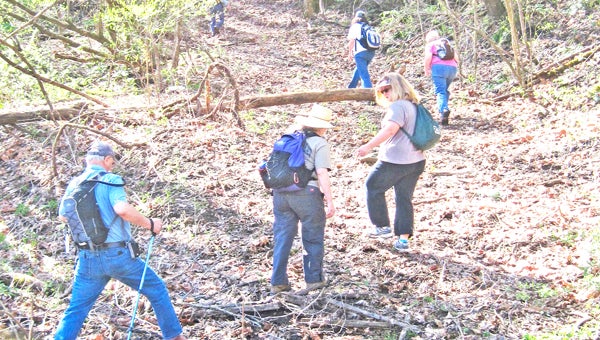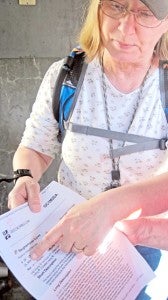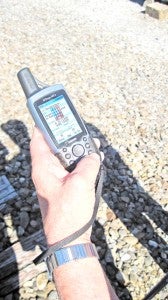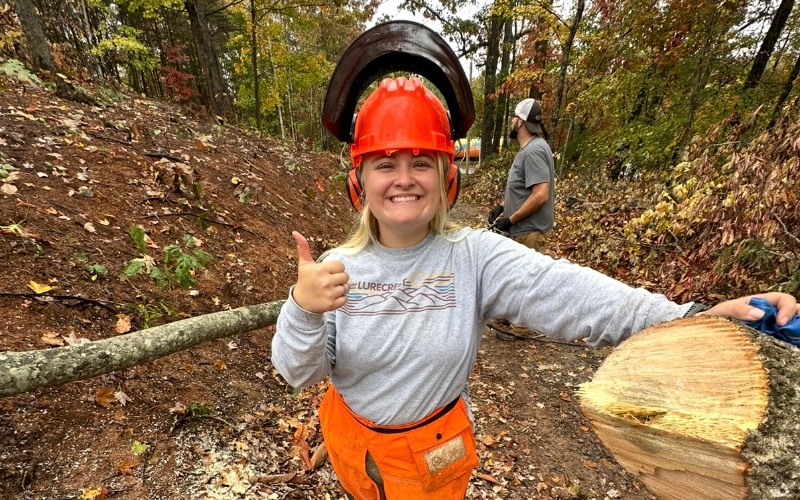Geocaching
Published 9:35 am Wednesday, April 13, 2011

Local geocachers snake their way through the water-soaked terrain of a hiking path toward their next geocache location. Many of the geocachers will tell you their favorite part of the hobby is traversing areas they had no other reason to venture into. (photo by Samantha Hurst)
A high-tech game of hide and seek
A warm breeze stirs through freshly–budded trees as a group springs out of SUVs, slings packs on their backs and checks their neon orange digital devices.
“Everybody got water?” asks Laura Bollinger, or Cachn’zoom as she’s known to this crew.
Ready to set forth on their latest excursion, these eight adults appear as eager as a crowd of teens headed to a rock concert. While they might see plenty of rock groups, they aren’t headed into a concert; they’re headed into the woods between Tryon and Saluda to geocache.
Wait, what’s geocaching?
“You try and describe geocaching to someone and they say, ‘Are you nuts?’” said Jan “Dear Dora” Nunziato of Fletcher.
Geocaching is a high-tech game of hide-and-seek.
An individual picks a location, records its global positioning coordinates and hides an item or “cache.” That person then visits an online site, typically geocaching.com, and posts the cache for others to attempt to find.
“It gives you an opportunity to get away from your computer and out in nature,” Dear Dora said. “It’s great for kids, too… it’s something your kids can do no matter what age they are and it keeps them active.”
Many cachers fall into the hobby by chance.
Leigh “Two Black Cats” Rogers read something about geocaching online and asked her husband for a GPS as a present. She began geocaching just a year ago and loves it, she said.
Dear Dora began geocaching in 2003, and now has 3,429 finds logged. She has 53 caches of her own, but also maintains more than 200 for two local couples whose health and schedules haven’t allowed them to be as active.
Equipped with all the essentials, this crowd came prepared for their recent geocaching excursion.
They’ve got packs filled with water, cameras, M&Ms and first aid kits, of course. They’ve also got the experience of thousands of cumulative “finds” logged online.
Calling from inside a white, hut-like structure alongside a railroad track, Dear Dora enthusiastically shouts, “I found them.”
What she found are the coordinates for the crew’s next destination, and there’s a bit of hiking to do to get there.
Jim Nunziato, a.k.a. “Atrus,” keys in the next coordinates, N 35 13.205 / W 082 19.459, and the group treks further into the woods, where brittle, brown leaves and parched twigs crunch and crackle underfoot.
Not all caches take you deep into the woods. As Dear Dora explains, there exist all levels of caches and all levels of geocachers.
There are easy “park and grab” finds in parking lots.
Then there are caches that challenge a cacher both mentally and physically. One local cache requires rappelling 25 feet down a waterfall.
For passionate cachers like most in this group, it’s all about the hunt and the destination.
Cachn’zoom of Mill Spring only began geocaching five months ago and has already logged 360 caches. She’s also placed seven of her own.
“Hers are good, too,” Dare2Geocache said. “No lame caches there.”
A lame cache to this group means a cache any one of them could discover without trying –– mainly found on guardrails and light poles.
Today, the search for this particular cache has the group delving into a piece of Polk County railroad history.
Polk County cacher Rabid Chipmunks planted the Slaughterhouse Curve cache in January 2009. With both difficulty and terrain levels at four out of five, only 16 people have logged finds for this cache.
The cache is particularly interesting, too, because it includes a lesson in the history of the railroad passage from Tryon to Saluda.
“I’m excited by all of the places geocaching takes me. I’ve been to a lot of places I would have never gone otherwise,” said Dare2Geocache (Ruth Atkins) of Fairview, N.C.
Kathy “Mudkat” Knowland of Fletcher hoists herself slowly up a steep embankment, grasping for strong tree limbs to prevent her from sliding back down on her way up under an old railroad trellis. There she discovers what everyone else looked right past –– the next coordinates.

Right: Jan Nunziato, or “Dear Dora,” points out the first pair of coordinates needed to begin the geocaching group’s adventure. (photo by Samantha Hurst)
The Slaughterhouse Curve cache is a multi-cache, meaning there are multiple steps to discover the final cache. As the group follows each set of coordinates, the terrain heightens the excitement and difficulty of the hunt. The scenery along the way includes railroad beds, waterfalls, huge rock cliffs and, as the cache page warns you online, poison ivy and stinging nettles, plants which cause itching that drives some people crazy. Remember to wear long pants, these geocachers caution.
Most cachers tend to place caches in ammo containers because they can withstand the elements. Caches, however, can be anything. They can be as small as pencil erasers or as large as a 4-foot-long ammo box. Some contain nothing but a rolled-up log, which allows cachers to record their name and the day they found the cache.
Other caches include trinkets or travel bugs intended for cachers to take around the country or the world.
One of Dare2Geocache’s travel bugs recently made it to Australia by way of another cacher. She has another special cache she plans to place in Indiana.
ToniGT or Toni Tweed and her husband, Gary, of Candler, N.C., once found the oldest active cache in America out in Kansas.
“We like to tore the front of our van off,” Gary said.
“But we got the cache,” ToniGT retorted.
Old Gray Climber (Don Benson of Lake Lure) can top that one. His weirdest find – a bleached out dead animal skull with a cache bolted inside.
“You are really only limited by your imagination,” Dear Dora said.
Caches can be placed anywhere with public access. Some are even located on private property, but only because the property owner allowed access.
“Just in downtown Tryon there are 17 of them,” Dear Dora said. “This area is pretty rich for its size in caches.”
Cachers often also host event caches to connect with others who enjoy the hobby.
“That’s what I love most about geocaching –– it’s not about the caches I make, it’s about the friends I make,” Dear Dora said. “There are a lot of very fine folks out there geocaching.”
Grasping into a deep, dark corner of the woods, Mudkat and OldGrayClimber discover the final cache. They yell to the crew, “We’ve got it,” which incites a dash of cheerful geocachers delighted to sign their name on yet another log and, of course, check out the “goodies” inside this rusted old ammo box.
This time the goodies include crusted old railroad ties appropriately befitting a cache steeped in local rail history. Each cacher signs his or her name to the log, then they take a couple of pictures and trek back out of the woods.
With the last bit of their adrenaline seeping out of their system, the geocachers slink down against rocks and trees, take a collective sigh and begin chatting about the next potential adventure.
To learn more, connect with other cachers or give your own geocaching skills a try on Slaughterhouse Curve (cache code GC1M2DA), visit geocaching.com or locally, ncmagcachers.com.
For more photographs from this group’s recent geocaching day, see tryondailybulletin.com.






